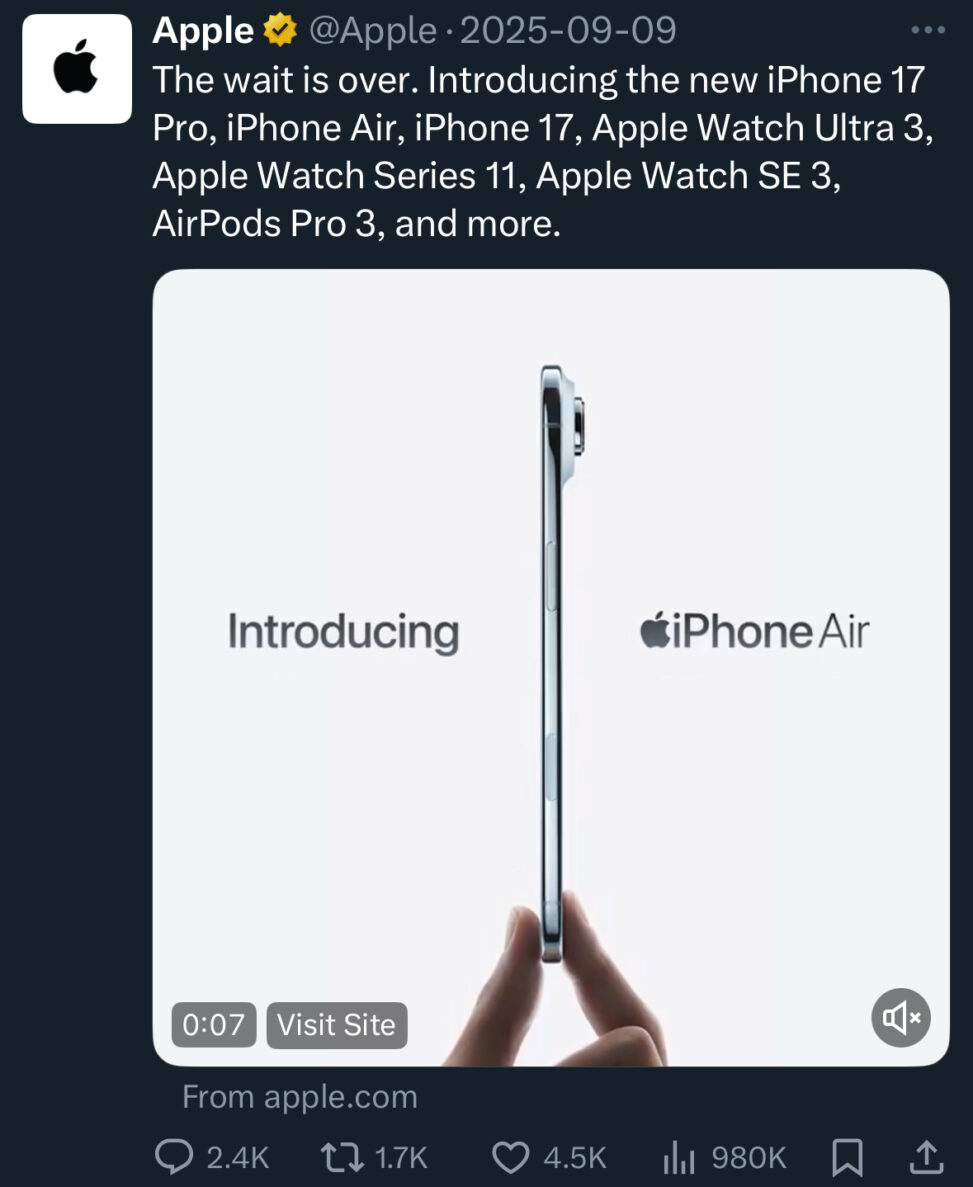I have selected an advertisement from Apple promoting their new line of apple products. This ad does not have a direct claim to being eco-friendly but Apple inc. has always claimed to have eco-friendly practices. For example, Apple has recently claimed that they have reduced their carbon emissions by 60%, they also claim to have reduced carbon emissions by 21.8 million tonnes in 2024 (1). As seen in the “Seven Ways to Spot Business Greenwashing” (2) article, Apple’s environmental declaration has these practices on their website. For starters reduced carbon emissions by 60% seems vague they use their 2015 baseline of carbon emissions and claim they want to reduce that number by 75%, the company has grown exponentially in the last decade, this would grant them a large margin of error. Which is an example of a hidden trade off and carbon offsetting. The claim they made about reduction of carbon emissions could likely be false as well as there is no actual proof in the website and instead uses buzzwords.
Another example of greenwashing from Apple would be the use of green buzzwords, on the website they use terms like “recycling”, “renewable sources”, “low-carbon”, etc. Apple also hides information, on their website they claim to use 99% recycled carbon in their batteries but do not acknowledge the fact that cobalt mining is a non-eco-friendly practice. Apple also uses that tactic of marketing eco-friendly products while trying to push aside the environmentally unfriendly products or strategies, for example Apple promotes “Daisy” a disassembling robot that can disassemble 200 phones in an hour. While this is a good practice for properly disassembling phones the website does not state what they do with those phones or where they put them. Apple often uses a deceitful practice called planned obsolescence, a common side effect of buying Apple products, known among Apple users is that around 3-4 years after purchase of an Apple product (iPhone, iPad, iMac, etc.) the product will start to show faults in its daily use, the products will perform functions slower, screens have more tendency to freeze, the battery drains faster, etc. Gecit speaks on planned obsolescence relating to electrical lambs produced by Shelby electrical company “…However, it is now challenging to find a lamb that lights for more than a couple of years. Even though technology has advanced dramatically in the last 100 years…” (3). This is also true with Apple products as they often plan to phase out their products to encourage users to buy newer model while decreasing environmental health due to the fact most Apple users will just throw them out haphazardly. Apple’s most famous case of planned obsolescence is “battery gate” where Apple users claimed that Apple was intentionally slowing down batteries in older smartphones (4).
This advertisement is trying to convince you to buy the advertised apple products and pair them with other products. Hsu states that “It is well known that the quality of a marketing strategy affects the performance of a company” (5). This is certainly true in the case of Apple as they have historically been a marketing giant ever since their infamous 1984 ad. This ad is trying to get you to accept the idea that you must purchase the advertised model to have an accepted social status. This ad is trying to rely on buyers’ knowledge of the Apple brand and hoping the buyer has brand loyalty to lull you into buying the new products being advertised without letting you in on all the questionable environmental practices that Apple uses to make their products. Apples target demographic is very broad ages 4-70 have been seen using and supporting Apple products advertised to them. Marketing towards or exploiting children is a theoretical concept covered in this course as when children have their sights set on something they must have they will beg their parents to buy these items for them. Being a 22-year-old male, I am the key target demographic for Apple. Nagamia adds to this by stating “Apple targets almost everyone, everywhere, as long as they can afford it’s expensive products” (6). The advertisement that I have chosen did not appeal to me, it did not have eye-catching visuals or anything that really wowed me. It was another run of the mill, generic ad you would usually scroll past without even mentally registering it. This is atypical of Apple as they generally have impressive advertisements that will leave you further questioning the capabilities of the product.
The situation I encountered this ad in was a causal scroll through X (Twitter), I then screen recorded the ad and cropped it slightly to make sure the whole ad was in frame and nothing that was unrelated to it. There is some text within the advertisement, it has a remark that the line of products is “awe dropping” and it has text when different products show up on screen to notify the viewer of which product it is. A theoretical concept used by Apple that is covered in this course is selling the same product in a different package, iPhones year to year have very marginal improvements.
In conclusion, this Apple advertisement is trying to get you to buy this years versions of Apple products and does not have an outstanding message of being eco-friendly but Apple consistently uses and is a part of greenwashing in a very broad way. Apple seems to be promoting themselves as more eco-friendly from 2025 onwards- this might be Apple forcing the consumer to choose between the lesser of two evils.


Ziyi Wang
Critique of “Apple’s Greenwashing” analysis
The student offers a forceful critique of Apple’s sustainability posture and wisely notes that the specific ad makes no explicit eco-claims. They frame the piece as brand-led desirability marketing that leans on Apple’s corporate reputation while sidestepping environmental substance. This is a fair starting point, but the greenwashing argument would be stronger if it distinguished clearly between implied claims in the ad and corporate-level claims elsewhere.
Main points summarized:
– Apple touts large emissions reductions using a 2015 baseline, which the student views as vague and potentially offset-reliant.
– The company uses green buzzwords and highlights initiatives (recycling, renewables, Daisy robot) while omitting upstream harms such as cobalt mining.
– Apple’s product cadence allegedly embeds planned obsolescence, with “Battery gate” as a flagship example.
– The ad itself is generic brand promotion aimed at broad demographics and social status signaling.
Use of scholarly sources:
– They cite conceptual pieces on marketing performance and planned obsolescence, plus popular guidance on spotting greenwashing. These are directionally relevant, but source types vary widely. Peer‑reviewed sustainability accounting or LCA studies, regulatory filings, or court documents on “Battery gate” would materially upgrade evidentiary rigor.
What’s missing:
– Verify Apple’s stated figures, scopes, and the role of offsets versus absolute reductions; specify Scope 1–3 and product use-phase impacts.
– Correct technical claims on materials (e.g., recycled cobalt vs “recycled carbon”) and provide traceability evidence.
– Address right‑to‑repair, software support lifecycles, and re‑use markets as countervailing factors to obsolescence.
– Tie the greenwashing critique to the ad’s actual semiotics and placement or explicitly confine it to corporate communications to avoid overreach.